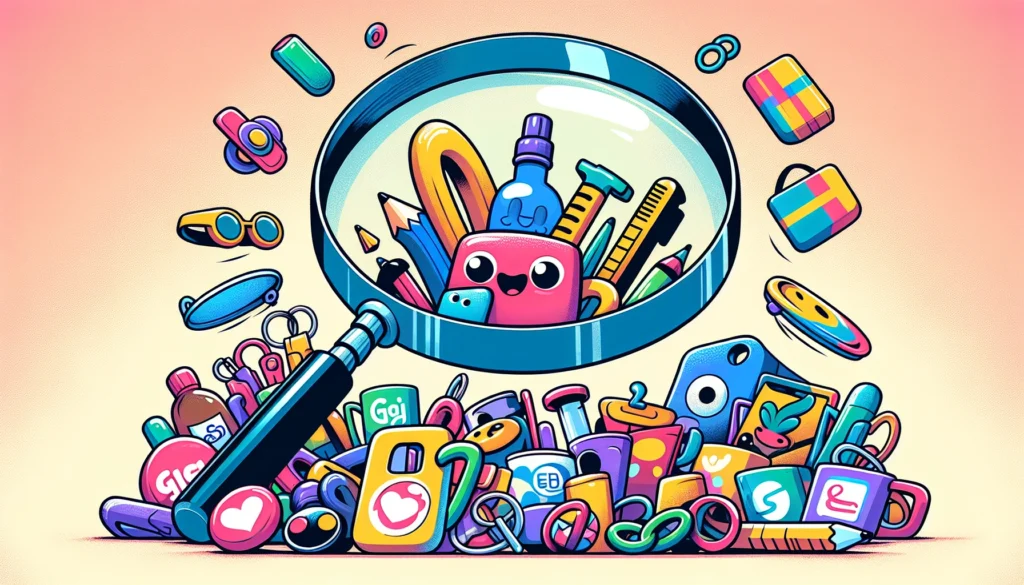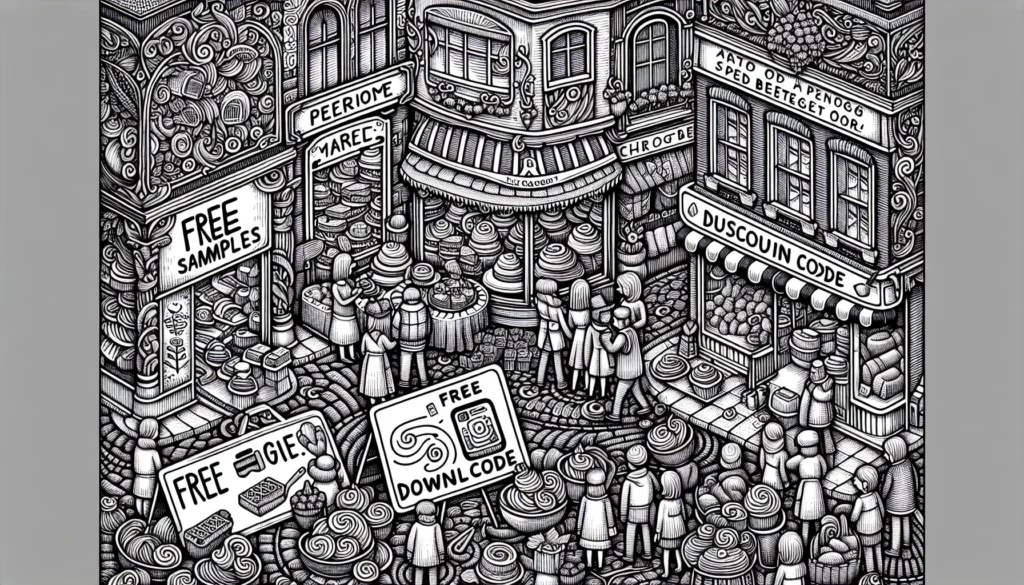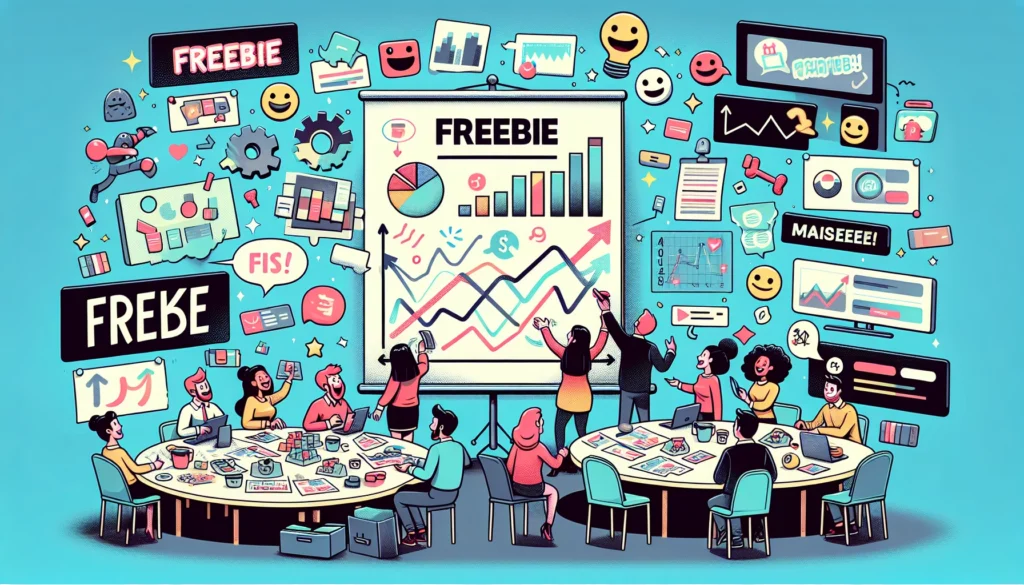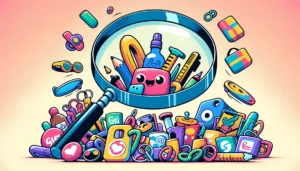Table of Contents[Hide][Show]
- Key Takeaways
15 Effective Freebie Ideas for Small Businesses+−
- 1. Ebooks and Guides
- 2. Templates and Checklists
- 3. Free Webinars or Online Workshops
- 4. Free Trials or Limited Feature Access
- 5. Email Mini-Courses
- 6. Printable Resources
- 7. Discount Codes for New Subscribers
- 8. Exclusive Facebook Group or Online Community Access
- 9. Quiz or Self-Assessment Tools
- 10. Social Media Challenges
- 11. Informative Video Series
- 12. Access to Free Online Tools or Calculators
- 13. Case Studies or Success Stories
- 14. Infographics and Cheat Sheets
- 15. Exclusive Access to a New Product or Feature
- Conclusion
Freebie marketing is where businesses give away a free product or service to get new customers and build brand loyalty. A good freebie can be a powerful lead magnet to pull in potential customers and get them to engage with your brand and overall digital marketing strategy. Freebie marketing is also a lead-gen tool for getting valuable contact info from potential customers. It’s a way to stand out in a crowded market. Here are ten freebie marketing ideas and how to use them.
Key Takeaways
Freebie marketing is an effective strategy to attract new customers, build brand loyalty, and stand out in competitive markets by offering complimentary products or services.
Selecting the right freebie that’s aligned with your brand and resonates with your target audience is crucial for the success of your marketing mix strategy and customer retention.
Effective promotion and measurement of freebie campaigns through various channels and tools can drive traffic, enhance engagement, and ultimately boost sales and customer loyalty.
Understanding Freebie Marketing

Freebie marketing allows businesses to connect with their target market, build customer relationships, and stand out in a crowded market. Getting something for free can be a winner in a market with many options. Plus, freebie marketing can increase brand awareness by getting your products or services in front of a bigger audience. Freebie marketing strategies, such as Jell-O’s success with recipe giveaways, are effective for brands to attract customers and increase sales. Here are some examples of freebies:
Free trials
Digital downloads
Limited-time offers
Exclusive access
This approach benefits businesses of all
What is Freebies Marketing?
Freebies marketing involves giving free products, services, or resources to your target market at no upfront cost. It’s a way to attract and retain customers. Freebie marketing’s purpose is to attract new customers and build brand loyalty through free offers or heavily discounted products. It’s most effective for customer acquisition, as it gives potential customers a reason to engage with your brand.
Ultimately, these campaigns will get consumers to buy by giving them an offer they can’t refuse.
How Freebie Marketing Works
Freebie marketing creates a good impression and reciprocity and showcases the offer. By giving away a gift with a purchase, businesses can get attention, engage
Benefits of Freebies Marketing
The benefits of freebies marketing are:
Increased brand awareness and customer loyalty
Customer acquisition
Loyalty
Trust
Freebies can increase brand awareness and strengthen customer relationships. They can also have a domino effect on sales and reduce marketing budgets.
Plus, strategically used freebies can help businesses stand out, compete with more prominent brands, and build a loyal customer base. Giving away high-quality freebies can showcase product quality and build customer trust and long-term loyalty.
Choosing the Right Freebie

The success of a freebie marketing strategy is all about choosing the right freebie that’s aligned with your brand and your target market. Analyzing existing marketing strategies can help identify unique angles that set your brand apart. Research your market to determine what freebies will work with your target market. A good freebie can attract potential customers and make your brand more attractive.
Giving away a good freebie can be a powerful magnet to attract potential customers to your brand and products. This will help you.
Know Your Target Audience
A deep understanding of your target market’s needs and wants will guide the choice of the right freebie. Start with a customer survey to ensure the offers are based on customer needs. Use tools like Google Analytics and social media insights to get more information.
Analyzing the survey results will help you find common patterns and needs and guide the creation of relevant freebies.
Align Freebies with Brand Values
Freebies that reflect your brand values will naturally extend your business and amplify your brand. To have an impact, the freebie you give away should align with your business values and goals and fit with your brand identity and messaging. For example, Nutrigold’s free container showed its commitment to sustainability.
Pairing freebies with complementary products can increase perceived value and encourage additional purchases
Analyzing Competitors’ Freebies
Researching your competitor’s freebies will highlight opportunities to differentiate and carve out a niche. Knowing what your competitors offer will help you find a unique angle for your freebie. Knowing your competitors’ actions will help you find a specific selling proposition for your freebie strategy.
It’s about finding what makes your freebie unique and exciting, not copying competitors.
15 Effective Freebie Ideas for Small Businesses

Many types of free offers can be created to raise brand awareness or grow your email lists, such as free products, templates, PDF guides, and discount codes, which are great lead magnets. Here are 15 effective freebie marketing ideas to help build brand awareness and capture leads:
1. Ebooks and Guides
- Create a valuable, downloadable ebook or guide that addresses common pain points or industry insights relevant to your audience. Promote it on your website and social media.
2. Templates and Checklists
- Offer ready-made templates, checklists, or worksheets (such as budgeting templates, social media calendars, or meal planning guides). People love tools that simplify tasks.
3. Free Webinars or Online Workshops
- Host a live or pre-recorded session sharing industry knowledge, tips, or how-to guides. They can serve as a preview of your expertise and services.
4. Free Trials or Limited Feature Access
- Provide a limited-time trial of your product or offer a “lite” version that users can upgrade for full features. This approach works especially well for software products.
5. Email Mini-Courses
- Deliver bite-sized, actionable lessons on a topic related to your business, directly to subscribers’ inboxes over a week or so.
6. Printable Resources
- Create printable content, like planners, coloring pages, or inspirational quotes, for users to download and print. This approach can be especially effective on Pinterest.
7. Discount Codes for New Subscribers
- Discount codes and coupons create urgency and drive immediate sales. Share discount codes via email, social media, or directly on your website to maximize reach, engage with potential customers, and increase sales. They can be a percentage off products or free shipping.
8. Exclusive Facebook Group or Online Community Access
- Build an exclusive online community where members can discuss relevant topics and receive valuable tips, positioning your brand as a hub for your niche.
9. Quiz or Self-Assessment Tools
- Develop a quiz that provides personalized recommendations or insights. At the end, offer related advice or product suggestions to drive interest.
10. Social Media Challenges
- Host a multi-day challenge on social media that encourages participants to share posts using a specific hashtag. Challenges can increase engagement and expand reach.
11. Informative Video Series
- Create a short video series tackling common questions in your niche. Post it on YouTube or Instagram and link back to your website or product for more information.
12. Access to Free Online Tools or Calculators
- Develop a simple tool, like a budget calculator, workout planner, or SEO analyzer, available for free on your website. These tools can drive traffic and promote sharing.
13. Case Studies or Success Stories
- Share case studies that showcase how you helped previous clients or solved specific problems. This is especially powerful for B2B services.
14. Infographics and Cheat Sheets
- Create visual content that summarizes complex information, making it easy to understand at a glance. This can be shared on social media and helps establish authority.
15. Exclusive Access to a New Product or Feature
- Give early access to a new product or feature for free to your most engaged customers. This creates excitement and builds brand loyalty among early adopters.
Creating Irresistible Opt-In Freebies

Creating an opt-in freebie involves designing eye-catching offers, providing high-value content, and promoting them. An opt-in freebie is designed to get potential customers to join an email list and can be a PDF, checklist, guide, eBook, or any other digital product as long as it has high-value content. Target your opt-in freebie to your ideal customer and make it actionable and useful.
The secret to an irresistible opt-in freebie is excellent content that provides value. This content strategy will attract and engage potential subscribers and get them to sign up for your newsletter.
Designing Eye-Catching Freebies
Eye-catching freebies make a good first impression and play a big role in attracting the right audience. Using design tools like Canva will help you create eye-catching freebies quickly and efficiently, including free logo design. The visual of the freebie will impact its perceived value and effectiveness.
Providing High-Value Content
High-value content shows the quality of your paid products and services and builds trust with your audience.
For example: Giving away free video courses will establish authority and create a trust-based relationship.
Promoting Opt-In Freebies
Promote opt-in freebies through multiple channels to maximize reach and engagement and incentivize potential customers to sign up. Collaborate with influencers in your niche to amplify the reach of your freebie offers.
Make sure that you include clear calls to action in your promotions to tell potential customers how to get their freebie.
Implementing Your Freebie Marketing Strategy

Deploying a freebie marketing strategy requires the following:
careful planning
efficient distribution
strategic promotion
success measurement
To put a freebies marketing strategy into action, ensure it aligns with your overall marketing plan and addresses a specific audience pain.
Researching your audience and market is key to creating freebie offers that will achieve the desired results for your target customer. Publishing free offers on your website and promoting them through multiple channels will drive traffic and conversions.
Planning Your Freebie Campaign
In the planning stage of a freebie campaign, you need to define clear goals, such as increasing expertise or reaching more people. Choose the right freebie that aligns with your brand and products. Freebies are not free; consider the cost of promotion, distribution, and associated marketing.
Distribution and Promotion
Promote your freebie through multiple channels, such as social media, email marketing, and in-store promotions. Offer freebies through email marketing, blog, or social media to convert one-time buyers into loyal advocates.
Collaborate with influencers to promote your freebies, leverage their trust, and reach your target audience.
Measuring Success
Use tools and customer surveys to collect data and feedback to measure the success of your freebie marketing.
Tracking the increase in email subscribers is an excellent way to measure the success of a freebie campaign.
Case Studies: Successful Freebie Marketing Campaigns
These case studies provide real-life examples of businesses using freebie marketing, showing how it can deliver real business results.
Nutrigold’s Branded Food Container
Nutrigold gave away a free, custom reusable food container with every purchase of their chocolate drink. The container has a laser-etched lid, so the logo won’t come off when washed.
This free, custom reusable food container is practical for daily work, school, and travel use.
Pejoy Waffle’s Eco-Friendly Tote Bag
Pejoy Waffle’s campaign included giving away a free printed canvas tote bag with every purchase of 2 x 33g boxes.
This freebie fits perfectly with their eco-friendly theme.
Bobby Diaper’s Free Storage Box
Bobby Diaper gave away a free storage box to solve a common problem for parents who have extra storage space. This box was especially useful for parents who needed storage solutions.
Common Pitfalls in Freebie Marketing
Avoid common freebie marketing mistakes to ensure your strategy works. Offering irrelevant freebies, bad promotions, and ignoring customer feedback are the common mistakes that can kill your efforts.
Customer feedback will show you areas for improvement and guide future strategies, so make sure to collect and analyze data from your freebie marketing.
Offering Irrelevant Freebies
Offering freebies that align with your brand and interest your target audience is critical to maximizing freebie marketing. To create freebies that resonate with your audience, ensure they are relevant and valuable.
Giving away freebies that don’t resonate with your audience will be missed opportunities and wasted resources.
Poor Promotion Strategies
Poor promotion of freebies will result in low engagement and poor returns on the campaign.
Not promoting your freebies through the proper channels will limit the reach and impact of your campaign.
Ignoring Customer Feedback
Customer feedback will show you areas for improvement and guide future strategies, so make sure to collect and analyze data from your freebie marketing.
Ignoring customer feedback means missing valuable insights on how your freebies meet customer needs and expectations.
Conclusion
Freebie marketing can deliver big results for your business by attracting new customers, building brand loyalty, and standing out in a crowded market. You can get the most out of this powerful strategy by understanding freebie marketing, choosing the right ones, creating opt-in freebies, and promoting them effectively. Avoid the mistakes and learn from the case studies. Now, get started with freebie marketing and watch your business grow.
Frequently Asked Questions
What is freebie marketing?
Freebie marketing is a promotional strategy for attracting new customers and building brand loyalty by giving away products, services, or valuable resources. It’s a way to connect with potential customers and build a positive brand image.
How does freebie marketing work?
Freebie marketing works by creating a positive impression, promoting reciprocity, and showcasing the offerings to convert recipients to loyal customers. It’s a powerful tool for attracting and retaining customers.
What are the advantages of freebie marketing?
Freebie marketing has many advantages, such as increasing brand awareness, getting new customers, building loyalty and trust, and standing out in a crowded market. It’s a business growth tool.
How do I choose the right freebie for my business?
To choose the right freebie for your business, understand your audience, align with your brand values, and find a unique angle by examining your competitors’ offerings. This will help you stand out and meet your audience’s needs.
What are some freebie ideas for small businesses?
Offering free samples or trial products, digital downloads, and discount codes or coupons are freebie ideas for small businesses. These will get potential customers and increase sales.
What are the advantages of freebie marketing?
Freebie marketing has many advantages, such as increasing brand awareness, getting new customers, building loyalty and trust, and standing out in a crowded market. It’s a business growth tool.

 Top 12 Interactive Content Ideas to Captivate Your Audience
Top 12 Interactive Content Ideas to Captivate Your Audience